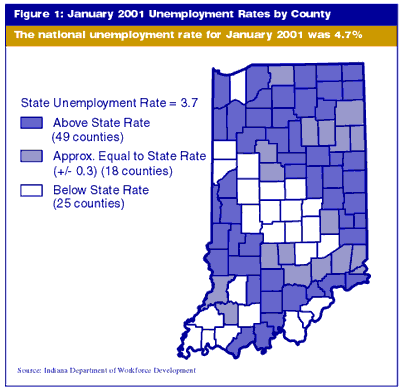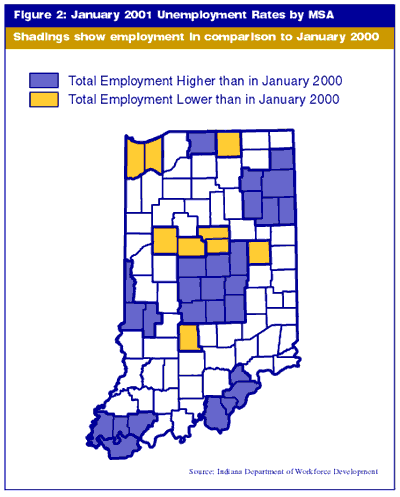Slight Jump in Unemployment Rates Normal This Time of Year
Indiana's unemployment rate edged up to 3.7% in January, according to figures just released by the Indiana Department of Workforce Development. The comparable rate for the nation on a non-seasonally adjusted basis was 4.7% in January.
Click on map to see larger version with data.

Indiana's January rate of 3.7% was up from the 2.7% rate reported for December 2000. A jump from December to January is normal, however. An increase to 3.7% does not by itself signal a recession in Indiana.
Anytime unemployment spreads, of course, it brings pain and disruption to those citizens who lose their jobs. From that standpoint, even a tiny rise in unemployment is bad news. The January rate is not necessarily bad news for the state as a whole, though. Analysts point to several facts that help put the higher unemployment number in perspective.
First, almost every January brings an uptick in the unemployment rate. Christmas workers leave payrolls and winter weather slows construction work. This combination nearly always pushes the unemployment rate higher in January, even in the best of times. January's increase, therefore, was to a large degree expected.
In addition, as shown by the line on the chart in Figure 2, the January report of 3.7% was the same as the rate posted in January 1999 and January 1998 (the January 2000 rate* was 3.4%). This January's rate was right in line with past Januarys in years of rapid economic expansion. If 3.7% was not bad news for the state economy then, it's hard to argue that it is bad news now.
*At the time of publication, the U.S. Bureau of Labor Statistics had not yet released benchmark data for 2000.

The January report held another very encouraging sign. Although the unemployment rate went up compared to December, total employment among Indiana residents also was up when compared to January last year. Employment numbers are shown by the bars in Figure 2.
IDWD reported there were 2,959,000 Hoosiers employed in January—a record high for the month of January. The figure was 2,957,000 the previous January. The economy of Indiana apparently is still generating new jobs despite the fact that unemployment also is higher.
There is another reason why a higher unemployment rate in January 2001 was to be expected. That is the uncertainty about the reported unemployment rates in the last four months of 2000. The process of estimating the state unemployment rate is usually very accurate, but there is always some margin of error. And there were indications that the calculations in September through December last year were coming out at the low end of that margin. If that was in fact the case, then we would have expected to see an increase in the reported rate in January, even if there was no actual change in unemployment, just to get the numbers back on track.
No one likes to see higher unemployment. Given the January numbers, though, there is no recession in sight yet for Indiana.
Some metro areas show weak economic results
Statewide, the economic numbers may have been comforting in January, but some of the state's metropolitan areas turned in much weaker performances.
Auto manufacturing layoffs in Kokomo helped doubled the unemployment rate there to 8% in January. Kokomo's rate, up from 4% in December, was by far the highest unemployment rate in any Indiana metro area.
Unemployment also rose in two metro areas that historically have turned in some of the state's strongest economic numbers. January unemployment in Bloomington and Elkhart-Goshen was up from December and also was higher than in January a year ago.
Other areas showed continued strength. Compared to the preceding January, this January's unemployment rate was down in Evansville, Gary, South Bend and Indianapolis.
Unemployment rates aside, as Figure 3 shows, some Indiana metro areas continue to grow in total employment. Evansville, Fort Wayne, Indianapolis, New Albany, South Bend and Terre Haute all had more people employed in January 2001 than in January a year ago. In the case of Indianapolis, the increase in employment over last January was more than 28,000 people.

